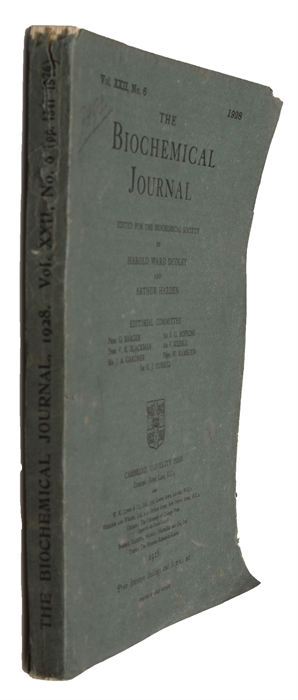DISCOVERY OF VITAMIN C - NOBEL PRIZE 1937
SZENT-GYÖRGI, ALBERT.
Observation on the function of peroxidase systems and the chemistry of the adrenal cortex. Description of a new corbohydrate derivative.
London, Cambridge University Press, 1928. Royal8vo. In the original printed wrappers. In "The Biochemical Journal", Vol. 22, 1928. Entire issue offered. Wrappers with nicks and ligt overall soiling. A tear to last 7 leaves. Internally fine and clean. Pp. 1387-1409. [Entire issue: Pp. (8), 1341-1575, (2), XIV, (1).].
First printing of Szent-Györgyi's landmark paper in which he for the first time discovered and isolated "hexuronic acid" or "ascorbic acid", today commonly known as vitamin C. In 1937 he was awarded the Nobel in Medicine "for his discoveries in connection with the biological combustion processes, with special reference to vitamin C and the catalysis of fumaric acid".
"Szent-Györgyi is most notably associated with the discovery of vitamin C. The discovery of vitamins themselves was recognized in 1929 in a Nobel Prize to Christiaan Eijkman and Gowland Hopkins. The search for vitamin C was then well underway in several labs. Ironically, the compound had already been isolated by Szent-Györgyi. Though no one-not even Szent-Györgyi-yet knew its identity." (DSB).
"In 1928 Szent-Györgyi had proposed that hexuronic acid, a highly reducing substance that he had isolated from oranges, cabbages and adrenal glands, was responsible for the anti-scurvy properties of fruit and vegetables, that is, that hexuronic acid was vitamin C. Zilva disagreed, citing work that he had done showing that vitamin activity and reducing power were independent of one another. There the matter lay for four years until, in 1932, Szent-Györgyi, carried out experiments to see whether hexuronic acid would protect guinea pigs from scurvy [which it indeed did]". (Smith, Nutrition in Britain, P. 45).
At the same time, for five years King's laboratory at the University of Pittsburgh had been trying to isolate the antiscorbutic factor in lemon juice using the original 1907 model of scorbutic guinea pigs which developed scurvy when not fed fresh foods but were cured by lemon juice. They had also considered hexuronic acid, but had been put off the trail when a coworker made the explicit (and mistaken) experimental claim that this substance was not the antiscorbutic substance.
Finally, in late 1931, Szent-Györgyi gave Svirbely, formerly of King's lab, the last of his hexuronic acid with the suggestion that it might be the anti-scorbutic factor. By the spring of 1932, King's laboratory had proven this but published the result without giving Szent-Györgyi credit for it, leading to a bitter dispute over priority claims.
Garrison & Morton 1059
Order-nr.: 49355

